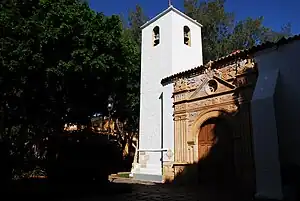Aztec influence in Spain can be seen in both the cuisine of Spain and in its architecture.
Food
Guacamole, an avocado-based dip that was popular in Aztec cuisine as early as the 16th century, was brought back to Spain by the Conquistadors.[1] Its reputation as an aphrodisiac derives from the words that combine to form the word ahuaca-molli ("guacamole" in the Aztec language): molli meant "something mashed or pureed into a sauce" and as well as meaning "avocado" ahuacatl meant "testicle".[1]
Architecture

Church of Nuestra Señora de Regla, Pájara
The stone work of sun pattern, snakes, panther and birds above the main entrance to the church of Nuestra Señora de Regla, Pájara, Fuerteventura in the Canary Islands, is thought by some specialists to show Aztec influence.[2][3]
See also
References
- 1 2 Zeldes, Leah A. (November 4, 2009). "Eat this! Guacamole, a singing sauce, on its day". Dining Chicago. Chicago's Restaurant & Entertainment Guide, Inc. Archived from the original on 7 November 2009. Retrieved November 5, 2009.
- ↑ Government of the Canary Island page gobcan.es, retrieved 14 December 2009
- ↑ Noel Rochford, Fuerteventura, Sunflower Books, 2007, p. 19
This article is issued from Wikipedia. The text is licensed under Creative Commons - Attribution - Sharealike. Additional terms may apply for the media files.